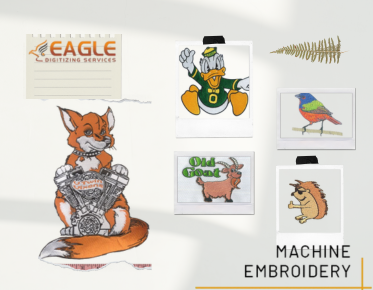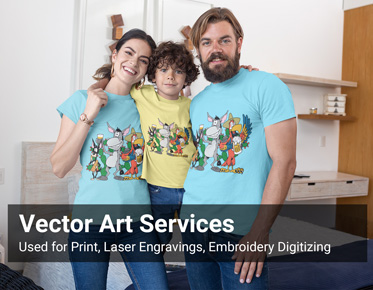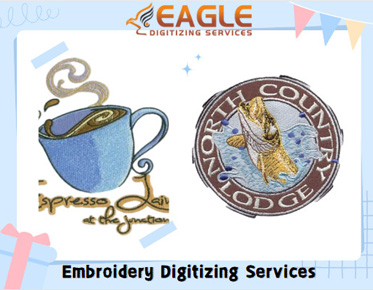Threads of Tomorrow: Navigating the Future Landscape of Embroidery and Digitization
Stitching Tomorrow: A Glimpse into the Future of Embroidery
and Digitizing
Embroidery, once a craft deeply
rooted in tradition and history, has seamlessly woven itself into the digital
landscape through the art of digitizing. As technology continues to advance at
a rapid pace, the future of embroidery and digitizing holds promises of
innovation and transformation. In this article, we delve into the crystal ball
to explore the predictions, emerging trends, and opportunities that lie ahead
in this dynamic industry.
- Integration of AI and
Machine Learning:
One of the most significant advancements on the horizon
for embroidery and digitizing is the integration of artificial intelligence
(AI) and machine learning algorithms. These technologies have the potential to
revolutionize the digitizing process by automating tasks such as pattern recognition,
color matching, and stitch selection. AI-powered software can analyze design
inputs and optimize them for embroidery, reducing the time and effort required
for manual digitizing.
- Customization and
Personalization:
In an era where personalization reigns supreme, the demand for customized embroidery is expected to soar. From monograms on apparel to intricate designs on accessories, consumers crave unique and personalized products. Digitizing software will play a pivotal role in enabling this trend by offering intuitive tools for creating bespoke embroidery designs. Moreover, advancements in 3D embroidery techniques may further enhance the level of customization, allowing for textured and multi-dimensional designs.
- Sustainable Embroidery
Practices:
With sustainability becoming a top priority for consumers
and businesses alike, the embroidery industry is poised to embrace eco-friendly
practices. From utilizing organic and recycled materials to adopting
energy-efficient production methods, there is a growing emphasis on
sustainability throughout the supply chain. Digitizing software can contribute
to this movement by optimizing design layouts to minimize material wastage and
reduce environmental impact.
- Expansion of Digital
Embroidery Marketplaces:
The proliferation of online marketplaces has democratized
the embroidery industry, allowing designers to showcase and sell their digital
embroidery files to a global audience. In the coming years, we can expect to
see the continued expansion of these digital marketplaces, offering a diverse
range of embroidery designs for enthusiasts and professionals alike. This trend
presents opportunities for freelance digitizers and designers to monetize their
skills and reach a broader customer base.
- Collaboration Between
Traditional and Digital Embroidery:
While digital embroidery has gained prominence in recent years, traditional embroidery techniques continue to hold cultural and artistic significance. In the future, we anticipate a harmonious collaboration between traditional and digital embroidery, where artisans leverage technology to enhance their craft while preserving its heritage. This synergy may result in hybrid embroidery styles that blend the intricacy of hand-stitched motifs with the precision of digital rendering.
Stitching
Personality: Elevating Home Decor with Embroidery
In the realm of interior design,
every stitch counts. From the soft embrace of a hand-sewn pillow to the
intricate detailing on a drapery, embroidery adds a touch of warmth and
personality to our living spaces. In recent years, the art of embroidery has experienced
a renaissance in home decor, offering a unique opportunity to infuse spaces
with creativity and charm. Let’s explore the enchanting world of embroidery and
discover how it can transform your living space into a personalized sanctuary.
The Art of Embroidery in Home Decor
Embroidery is more than just
needle and thread; it’s a form of artistic expression that transcends time.
Dating back centuries, embroidery has adorned everything from clothing to
tapestries, telling stories and capturing the essence of different cultures.
Today, this age-old craft finds its place in modern interiors, bringing a sense
of nostalgia and handmade authenticity to contemporary spaces.
Adding Personality and Charm
One of the most captivating aspects of
embroidery in home decor is its ability to infuse personality and charm into
every stitch. Whether it’s a delicate floral pattern on a throw pillow or a
whimsical motif on a tablecloth, embroidery adds a unique touch that speaks to
individual taste and style. By incorporating handcrafted elements into your
decor, you create a sense of warmth and intimacy that can’t be replicated by
mass-produced items.
Creative Incorporation in Interior Design
Now, let’s delve into the creative ways you can
incorporate embroidery into your interior design projects:
- Customized
Upholstery: Transform
ordinary furniture pieces into one-of-a-kind treasures by embellishing
them with embroidered accents. Consider adding embroidered borders to
chair cushions or intricate motifs to the back of dining chairs for a
touch of elegance.
- Statement Wall Art: Elevate your walls with embroidered artwork
that doubles as a focal point in any room. Frame embroidered fabric or
create your own embroidery hoop art featuring intricate designs or
inspirational quotes.
- Textured Textiles: Infuse your space with texture and depth by
incorporating embroidered textiles such as curtains, throws, and bedding.
Opt for embroidered linens in rich colors and patterns to add visual
interest and a luxurious feel to your decor.
- Personalized Accessories: Add a personal touch to your space with
embroidered accessories such as throw pillows, blankets, and table
runners. Customize these items with monograms, family crests, or
meaningful symbols to create a sense of nostalgia and belonging.
- DIY Decor Projects: Unleash your creativity with DIY embroidery projects that allow you to customize your decor according to your preferences. From embroidered lampshades to embellished wall hangings, the possibilities are endless when it comes to incorporating embroidery into your home decor.
The Art of Minimalism: Embracing
Simplicity in Embroidery
In a world filled with constant noise and clutter, the allure of simplicity has become a beacon of tranquility for many. From minimalist interior design to capsule wardrobes, the philosophy of less is more has permeated various aspects of our lives. In recent years, this ethos has found its way into the realm of embroidery, where intricate designs are giving way to minimalist masterpieces that make a bold statement through their simplicity.
The growing popularity of minimalist embroidery designs is a testament to our collective yearning for simplicity in a complex world. What was once seen as a craft reserved for grandiose patterns and elaborate stitches is now being redefined by artists who are embracing the beauty of minimalism. These contemporary embroiderers are stripping away the excess, focusing instead on clean lines, negative space, and subtle details to create works of art that are both understated and impactful.
So, what exactly defines minimalist embroidery? At its core, minimalist embroidery is about paring down designs to their essential elements. This means opting for simple shapes, limited color palettes, and uncomplicated stitches. By doing away with unnecessary embellishments, minimalist embroiderers are able to draw attention to the beauty of each stitch and the interplay of thread against fabric.
One of the key benefits of minimalist embroidery lies in its versatility. Whether adorning a piece of clothing, a household item, or a piece of art, minimalist designs have a timeless appeal that can complement any aesthetic. From delicate florals to abstract geometric patterns, there is a minimalist embroidery design to suit every taste and style.
But beyond its aesthetic appeal, minimalist embroidery also offers a deeper sense of satisfaction for both creators and viewers alike. In a world where we are constantly bombarded with stimuli, there is something incredibly gratifying about the simplicity of a well-executed minimalist design. It allows us to pause, to breathe, and to appreciate the beauty in the ordinary.
Moreover, minimalist embroidery encourages us to rethink our relationship with material possessions. In a culture that often equates value with excess, embracing simplicity in our embroidery reminds us that true beauty lies not in the quantity of our possessions, but in the thoughtfulness and intention behind each creation.
So how can you embrace simplicity in your own embroidery projects? Start by paring down your designs to their essential elements. Consider using fewer colors and limiting the number of stitches you use. Experiment with negative space to create balance and visual interest. And above all, let go of the pressure to create something grandiose or elaborate. Remember that beauty can be found in the simplest of stitches.
In conclusion, the growing popularity of minimalist embroidery designs speaks to our innate desire for simplicity and tranquility in an increasingly complex world. By embracing minimalism in our embroidery, we not only create works of art that are visually striking but also cultivate a deeper appreciation for the beauty of simplicity in all aspects of our lives. So why not pick up a needle and thread and discover the power of minimalism for yourself?
As we gaze into the future of embroidery and digitizing, it's evident that the landscape is poised for remarkable transformation. The integration of AI and machine learning stands as a beacon of efficiency, promising to streamline processes and unlock new realms of creativity. Meanwhile, the surge in demand for personalized embroidery underscores a shift towards individuality and self-expression, fueled by innovative digitizing tools and techniques.
Moreover, as sustainability takes center stage, the industry's commitment to eco-friendly practices heralds a greener, more conscientious future. The expansion of digital marketplaces democratizes access to embroidery designs, empowering creators and enthusiasts worldwide. And perhaps most intriguingly, the harmonious collaboration between traditional and digital embroidery signals a fusion of heritage and innovation, paving the way for hybrid styles that honor the past while embracing the future.
In the realm of interior design, embroidery emerges as a powerful tool for personalization, infusing spaces with warmth, charm, and individuality. From customized upholstery to statement wall art, its versatility knows no bounds, offering endless opportunities for creative expression. And in embracing the ethos of minimalism, embroidery transcends mere decoration, becoming a conduit for simplicity, tranquility, and mindful living.
As we embark on this journey into
the future of embroidery, let us embrace innovation, celebrate tradition, and
above all, stitch together a tapestry of creativity that reflects the beauty
and diversity of our world.



